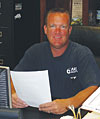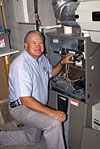
Paul Cosner spends a lot of time educating his customers
about the Comfort Control system. He explains that while the initial investment
may be more, the cost savings and utilities will be great.
Fortunately, things have become much easier. All manufacturers now offer programmable thermostats that are easy to understand and simple to program. These controls don’t just make life less complicated for the homeowner, though; dealers also love how easy they are to install and how well the smart systems communicate with the technician and the homeowner. An added benefit is that these smart controls are highly intuitive, resulting in environments that are more comfortable and customers who are not as intimidated by their heating and cooling systems.
FAVORITE FEATURES
Paul DeHart, president, Bolster-DeHart, Inc., Pittsburgh, is a Bryant dealer who works mainly on high-end homes, where he installs numerous variable-speed heating and cooling systems that feature smart controls. “Customers don’t really know what the Evolution Control can do, so we usually have to explain the benefits when we’re selling these systems,” he stated.Once customers understand how the controls optimize system performance and enhance their comfort, they’re usually sold on the system. DeHart said that customers frequently comment on the large, easy-to-read display on the thermostat and the fact that it’s a user-friendly system to program. “We’ve had customers who have programmed these without even reading the books. There’s not a lot of industry jargon or codes that are used, and customers also really like operating their humidifiers from one location. They also like that the thermostat tells them when the filter needs to be replaced or if the UV light bulb needs to be changed.”
Dehumidification is another option that’s available with the control, and the thermostat will turn on the system without letting the house become too cold. DeHart likes what the control can do for his technicians as well. “It performs diagnostics, so our guys can pick up any fault codes in the system. It will report the static pressure of the system, so we can usually figure out if the problem is a dirty filter or an undersized duct system. It also gives us the model number and serial numbers off the equipment, as opposed to going outside or going to the furnace to find them.”
Paul Cosner, president, P.A.C. Heating & Air Conditioning, Lakeside, Calif., spends a lot of time educating his customers about the smart aspects of Rheem equipment. “When customers want a Comfort Control system, we talk about how they’ll also get a thermostat that communicates with them. People who live in two-story houses really love the remote sensing feature of the thermostat, because it keeps the house more comfortable.”
This remote sensing option basically eliminates hot and cold spots by using sensors to analyze the temperature at various locations in a house. Many homeowners complain that in the summer, the downstairs is cool, while the upstairs is hot, and vice versa in the winter. “We can take the remote sensor and place it upstairs and the downstairs thermostat weighs the difference in temperature between the upstairs and downstairs, keeping the whole house comfortable without spending a lot of money on two systems,” said Cosner.

Mike Ball likes installing equipment with self-diagnostic
features. He notes that the self-diagnostics are a “really big deal” when it
comes to running down little problems.
SMART ON THE INSIDE
While the smart thermostat is the part of the system that the customer sees, dealers are often more interested in the smart controls residing within the equipment. Mike Ball, president, Ball Heating & Air Conditioning, Andover, Kan., specializes in the higher-end market and sells primarily on comfort and utility savings. “We install quite a bit of York equipment, especially their two-stage air conditioners and furnaces, which feature self-diagnostics. What really sets York apart is their board setup: You can set it up the way you want, and the self-diagnostics are a really big deal when it comes to running down little problems.”Customers especially like York’s modulating gas furnace, said Ball, which is very intuitive in that it matches the capacity to the load automatically. These smart systems may result in a few cost objections from customers, but Ball notes that he builds value in the system he’s recommending when he talks to homeowners. “I love it when customers say, ‘My family is going to bury me in the backyard’ because that tells me they’re going to be in their home long term. Once you assure customers that you can meet their comfort expectations, it’s easy to sell the smart systems.”
Kevin Kirsh, vice president and general manager, Midlothian Mechanical, Richmond, Va., is also a fan of the York modulating furnace, noting that these systems maintain a constant temperature while delivering improved comfort, quieter operation, and reduced energy costs. He liked the system so much that he installed one in his own home, so he could show his low monthly gas bills to customers.
The best way to sell these systems is to train technicians and educate the homeowner, said Kirsh. “The key is training, especially for our technicians. Setup is everything - for the customer as well as the technician. As for homeowners, if you provide them with proper education, they will see the difference between installing a high-efficiency unit vs. a mid-efficiency unit. And if they can pop popcorn in a microwave, they can learn how to use the controls.”
Dealers and customers both seem very happy with the new smart controls that are widely available on heating and cooling equipment. As Ball noted, these high-tech controls may also serve another purpose: bringing new blood into the industry. “The higher tech we go with smart systems, the easier it will be to attract young people to the HVACR profession. We have to let young people know that this is a high-tech field.”
Publication date:11/26/2007


Report Abusive Comment